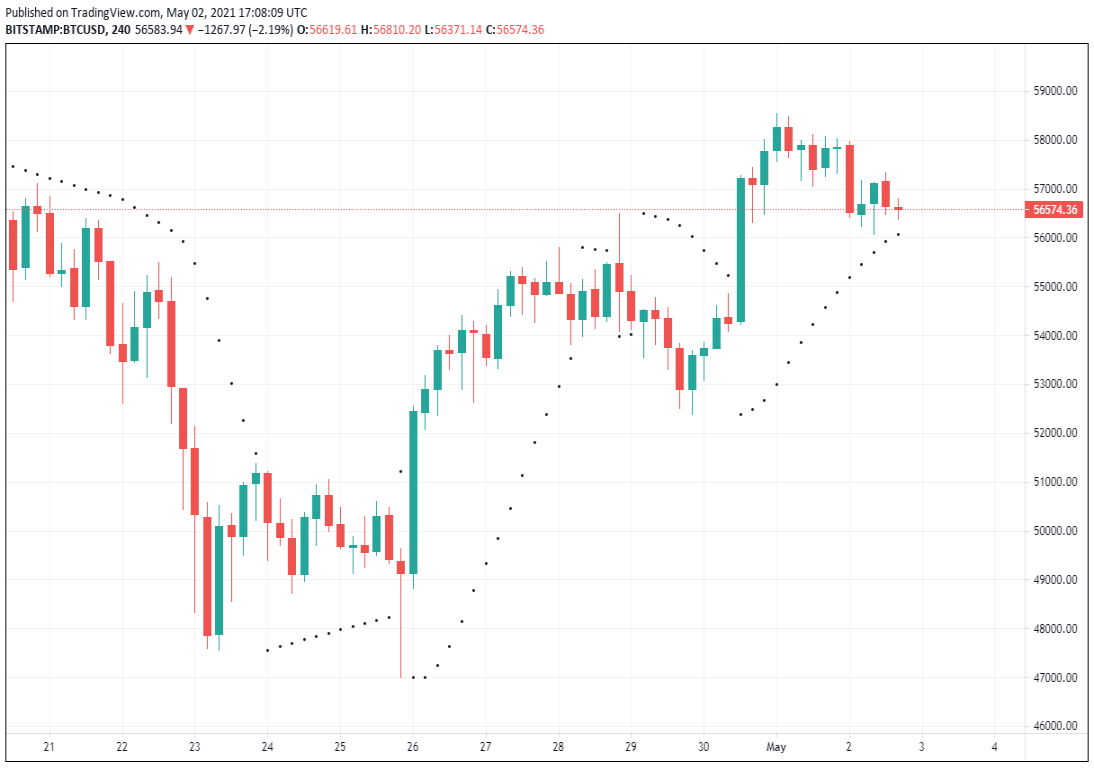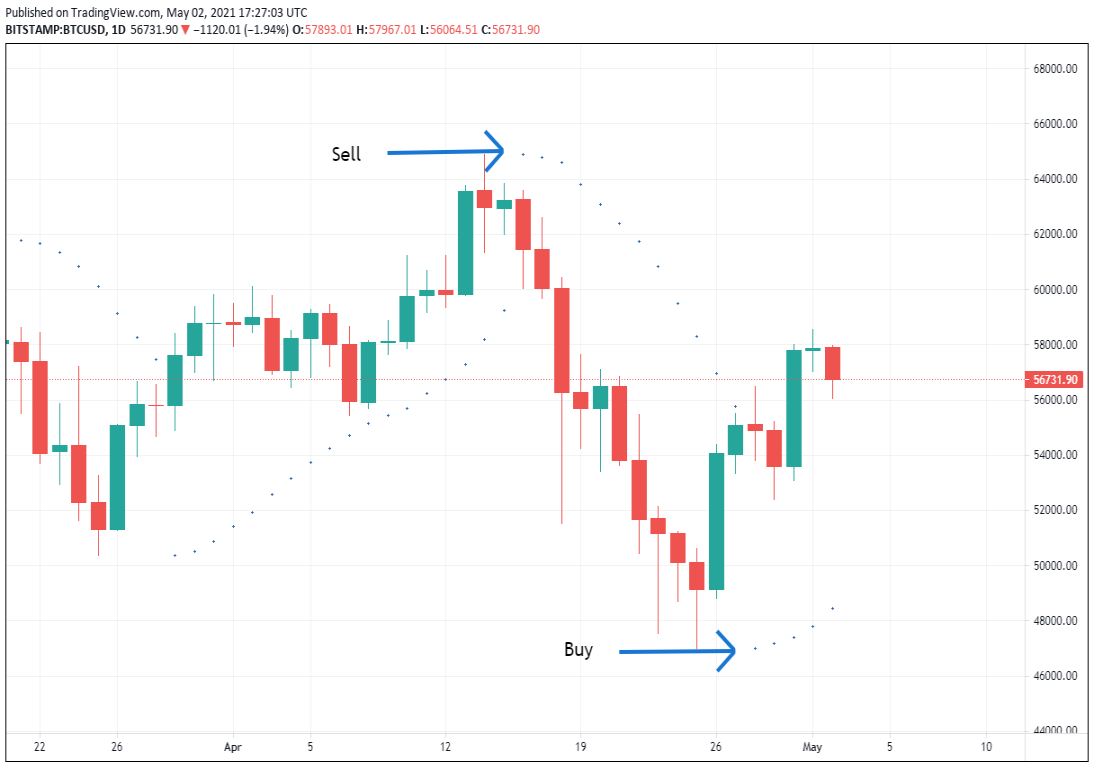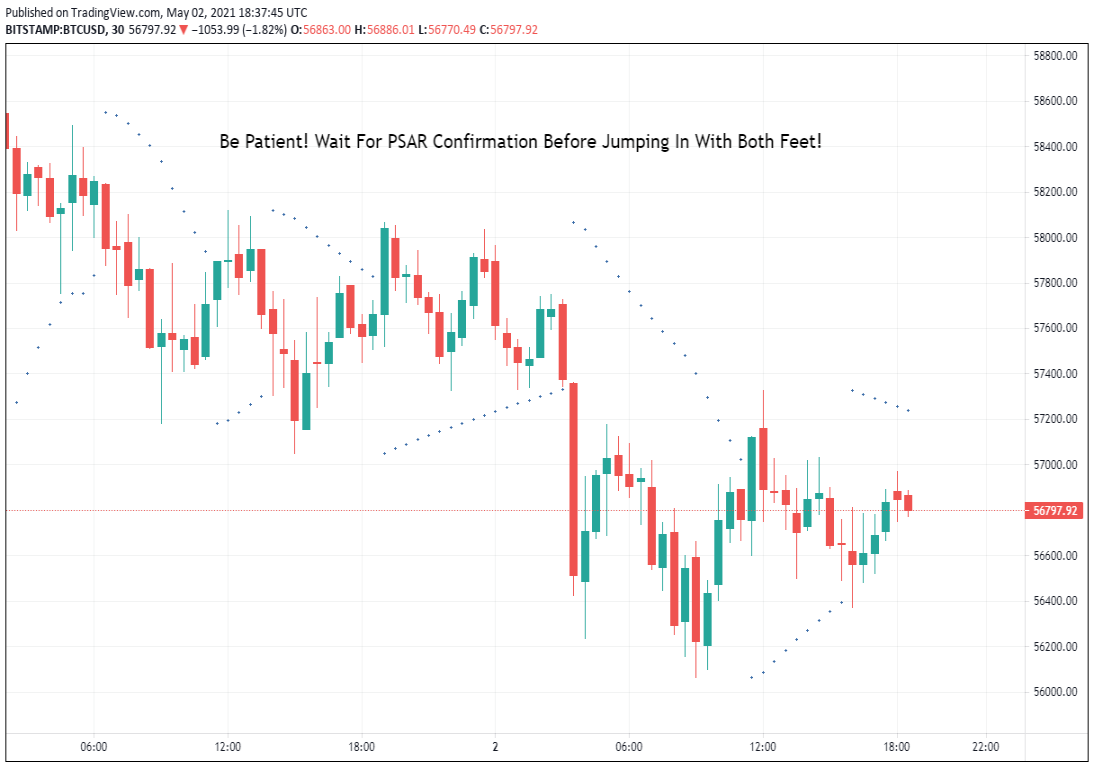Crypto Strategy: Parabolic SAR
Last Update: October 28th, 2021
The parabolic stop-and-reversal, or parabolic SAR (PSAR), is a technical tool used to identify the direction of price action. Developed in the 1970s by famous market technician Welles Wilder Jr., the parabolic SAR is a trend and reversal trading indicator with a multitude of applications. It is commonly used in the trade of crypto, forex, futures, and equity products.
First introduced in Wilder’s 1978 book “New Concepts In Technical Trading Systems,” the parabolic SAR is classified as being a lagging indicator. While often used in isolation, it compliments moving averages, stochastics, and RSI (also developed by Wilder).
How Does The Parabolic SAR Work?
One of the key attributes of the parabolic SAR is that it is an intuitive, user-friendly trading tool. As in the name “stop and reversal,” the indicator aims to signal traders when a prevailing trend is nearing exhaustion and ready to change course. This is accomplished by comparing periodic extremes and integrating a multiplier. From a practical standpoint, the PSAR calculation is involved and makes two foundational assumptions:
- EP: The EP, or “extreme point,” is a bullish or bearish trend’s periodic high or low.
- AF: The AF, or “acceleration factor,” is a multiplier used to offset the value for graphic representation. Typically, the AF is set at 0.02.
Given the EP and AF, the PSAR is calculated as follows:
- Uptrend: PSAR = Prior PSAR + (Prior AF(Prior EP – Prior PSAR))
- Downtrend: PSAR = Prior PSAR + (Prior AF(Prior PSAR – Prior EP))
Confused? Don’t be ― the PSAR is a public domain indicator that is calculated and graphed automatically by most software trading platforms. It is represented by a dot below (uptrend) or above (downtrend) select pricing bars. As an example, the chart below is how the PSAR looks on a four-hour Bitcoin chart.

How Is The Parabolic SAR Used In Crypto?
As you can see from the chart above, using parabolic SAR in crypto trading is simple. In an uptrend, the dots are below price and moving upward; in a downtrend, the opposite is true. Given its intuitive presentation, the PSAR is ideal for trend and reversal trading. The PSAR signals that one of three actions is possible at any given time:
- Buy: If the dots are beneath price, a buy is suggested. Also, the greater the upward slope of the dots, the stronger the bullish trend.
- Sell: If the dots are above price, a sell is suggested. In addition, the greater the downward slope of the dots, the stronger the bearish trend.
- Neutral: During consolidation patterns or sideways action, the PSAR will still print dots above or below price action. However, they will have a flat trajectory and are less reliable. When in rotational cryptocurrency market conditions, it is best to wait until the market breaks out and chooses a direction before entering a trade.
The key element of trading cryptocurrencies with the PSAR is recognizing when the dots cross over price. When this happens, it is considered to be a sign of reversal and a potential buy or sell signal. For example, check out the daily Bitcoin chart below. As you can see, a formidable daily downtrend begins at April’s spike high near $65,000. At this point, the dots jumped above price, signalling that it was time to sell. The opposite scenario was true when BTC posted its April low near $46,000.

Things To Watch Out For When Trading Crypto With The Parabolic SAR
Like using the parabolic SAR in forex trading, there are a few things to watch out for in crypto. Here’s a brief look at three of the most important:
- False Signals: If you’ve read any of our other articles on technical analysis, then you are familiar with the concept of false signals. Unfortunately, the PSAR isn’t immune to generating misleading crypto buy and sell signals. During periods of market consolidation or rotation, the indicator has a tendency to frequently cross over price. The choppy, non committal price action leads to many periodic extremes being created, thus compromising the PSAR’s efficacy. However, it is possible to reduce the number of false buy and sell signals. A few of the most common ways are to wait for multiple dots to appear before entering the market or combine the PSAR with another technical tool. In doing so, you can confirm the relevance of a pending reversal, adding to the confidence of the signal.
- Fundamentals: Due to the fact that the PSAR is a trend and reversal indicator, it is imperative that current crypto market fundamentals are not ignored. If the PSAR is being used within the context of a trend following or reversal strategy, then you may be holding positions in the open market for a significant period of time. In the event that a breaking news item shakes up valuations during a live trade, the sudden spike in volatility is likely to skew pricing charts and disrupt the PSAR’s function. Should this occur, losses or false signals are possible results. No matter the implementation of the PSAR, it is important to evaluate the crypto market fundamentals as they evolve. Be sure to take note when new regulations are announced, industry rumors go viral, or security breaches come to pass.
- Risk Vs Reward: One of the key benefits of the PSAR trading strategy is that it aims to capture profits from trends and reversals. As a general rule, the profit targets involved with trading reversals and trends are much larger than in scalping or rotational strategies. Accordingly, viable risk vs reward ratios can be upwards of 1:3 due to the directional nature of the pricing moves in question. While the success rate of such trades may be minimal, the potential profitability of trends and reversals is far greater than from scalps and reversions. Additionally, the PSAR is a valuable tool for aligning risk to reward in live market conditions. In fact, many crypto traders use the PSAR as a signal to exit open positions in real-time. The result is a streamlined, dynamic approach to managing risk and reward.
Predicting Prices With The Parabolic SAR
Crypto price prediction is always a delicate endeavor, specifically during periods of high volatility. When using the PSAR to attempt this task, it’s a good idea to view the market in broad terms. Remember, it is a lagging, trend-oriented indicator; this means that the data (dots) is reflective of what has happened, not what will happen. Specific price points are hard to come by, but the dot crossovers are key. When the PSAR crosses over current price, it is safe to say that the market is under reversal. If this is the case, then short-term price action is likely to follow suit. Of course, accurately estimating how long price will move directionally depends upon a myriad of other technical and fundamental factors.
Pros And Cons Of The Parabolic SAR
| Pros | Cons |
| Provides easy-to-use visual cues on when to buy or sell crypto | The PSAR is a lagging indicator, so it’s one step behind evolving crypto price action |
| May be applied to any cryptocurrency on any timeframe | Does not address crypto trend strength |
| Compliments other indicators such as the RSI and Stochastics | In consolidating crypto markets, the PSAR often produces an abundance of false signals |
Common Mistakes To Avoid When Using The Parabolic SAR
No matter how strong a crypto indicator or trading signal is, it’s still possible to make mistakes. Here are are several of the most common made when trading the PSAR:
- Overleveraging: No indicator is infallible! Be sure to practice sound risk management and avoid using too much leverage.
- Premature Market Entry: In many cases, traders are anxious to enter the market and do not wait for PSAR confirmation. To be successful using this indicator, it’s a good idea to wait for more than one dot before entering a new trend.
Apply To Sideways Markets: The PSAR is not a rotational or breakout indicator. If you’re going to use it to trade cryptos, wait for periods of enhanced volatility or clear-cut trends.

Get Started
The parabolic SAR is a great trend and reversal trading tool. It’s easy to read, understand, and produces clear-cut signals. When applied within the context of a comprehensive cryptocurrency market plan, the PSAR can be an invaluable tool for active traders. If you’re interested in trading cryptos using technical analysis, the PSAR is a fantastic place to start.




